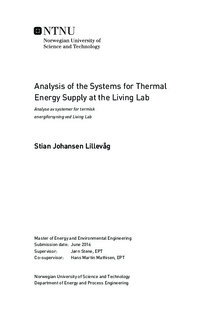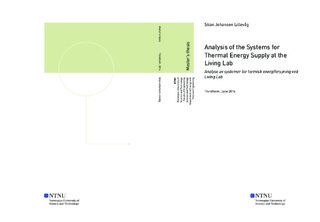| dc.description.abstract | The main purpose of this Master's Thesis has been to analyze the systems for thermal energy supply at the ZEB Living Lab, at NTNU, Trondheim. The 102 m^2 single-family house is designed and built in accordance with the Norwegian passive house standard, as a Zero Emission Building. Efficient utilization of on-site renewable heat sources, such as ground and solar heat, are thus essential means to reach this ambitious goal.
The thermal energy supply system comprises a 3.2 kW ground-source heat pump unit, 4.2 m^2 of south façade-mounted solar panels, a 400 l integrated water tank, including two 3.0 kW back-up heaters, and an hydronic heat distribution system. A combination of theoretical and experimental approaches have been applied in the analyze. Thermal energy and power demands from SIMIEN simulations, resulted in a heat pump power coverage factor of 54 %, at 0/35 °C. Energy coverage factors were 70 % and 85 %, with and without DHW heat supply. Corresponding SPF values were 2.56 and 3.52. Polysun simulations of the solar thermal system gave an annual solar fraction of 0.37, and a value of 0.6 for DHW heating during the summertime.
Results and observations from measurements have revealed a potential for improvement of system operating strategies, performance, design and dimensioning. The heat pump system is designed for alternate operation between space and DHW heating, but is currently incapable of the latter. Direct-acting electricity is thus an important heat producer in the system. The solar thermal system is designed for combined space and DHW heating, but is operated too intermittently to provide significant heat input. Low-temperature solar heating is furthermore prioritized by the integrated water tank, which restricts the potential for high-temperature DHW heating during the summer. Field measurements have shown a significant electric power consumption for operation of pumps. The electric power input to the ground circuit pump, for instance, corresponded to 15 % of the power input to the heat pump compressor. This contributed to a 13.5 % reduction in the heat pump system COP. Replacement of the brine solution is one of the suggested measures to redeem this deficiency.
In order to obtain the energy savings necessary to reach the ZEB goal, it is essential that the electric energy input to pumps and electric heaters is minimized. Meanwhile, the operating time for the heat pump unit and solar thermal system has to be extended. It is also essential that the measuring equipment is fully functional, so that the system energy performance can be documented. | |

